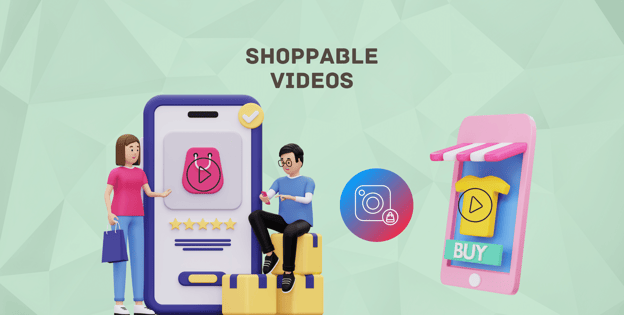Have you ever wondered which segment dominates the digital advertising landscape? Surprisingly, the Digital Video Advertising market emerges as the fourth largest market, with a projected revenue surge from US$176 billion in 2023 and expected to reach US$241 billion in 2028.
This growth is fueled by the fact that video has become the preferred content format for consumers. However, keeping up with changing digital marketing trends in technology and consumer preferences can be a challenge for marketers and business owners.
As of January 2023, Facebook stood as the primary social media platform for global marketers, with 89% using it to promote their businesses, followed by Instagram at 80%, as per a survey.
Marketers adapt and use these platforms to reach their target audience. This blog will help you get insights into the latest trends in video advertising, including interactive videos, live streaming, and short-form content, and how these can integrated into a brand’s digital strategy.
What is Video Advertising?
Video advertising refers to the practice of promoting products, services, or brands through the use of video content.
Video advertising can take various forms, including traditional TV commercials, social media video content, etc.
Key elements of video advertising include storytelling, visual appeal, and audio elements to convey a compelling message.
The goal is to capture the audience's attention, communicate the brand message effectively, and drive engagement or action.
With the rise of digital platforms and social media, online video advertising has become particularly prevalent. This includes ads on platforms like YouTube, Facebook, Instagram, TikTok, and YouTube.
Key Trends in Video Advertising:
Short-Form Video Advertising:
Short-form videos are gaining popularity nowadays. All thanks to platforms like TikTok and Instagram Reels. This trend emphasizes the need for brands to create brief, attention-grabbing videos that quickly convey compelling messages.
For instance, A snappy video for a fitness app, highlighting quick workout routines during a health awareness campaign. This short clip effectively demonstrated the app's features, emphasizing the convenience of brief, impactful exercises.
Short videos are highly shareable. Additionally, when it comes to social media marketing, short videos boast the highest return on investment (ROI) compared to other strategies. Brands can further repurpose their short-rich content using an MP4 converter. This makes the video accessible in many different formats. Thus, increasing their reach.
|
Tip! To succeed in video marketing, especially on social media platforms, prioritizing the creation of concise, engaging short-form videos is crucial |
Vertical Mobile Video Advertising Format:
Given the predominant use of mobile devices for video consumption, there is a growing emphasis on creating vertical videos tailored for seamless viewing on mobile screens.
Its demand is increasing as evidenced by the popularity of TikTok videos. All other platforms are now focusing on creating vertical mobile video content.
MediaBrix, a mobile ad platform, discovered that vertical videos boast a 90% higher completion rate than horizontal videos. Investing in tools that can convert your video to text might be a smart move. The conversion can help in creating transcripts or descriptions that enhance your video's SEO performance, hence, boosting its visibility and completion rate.
Brands are adapting their content to integrate into users' mobile experiences.
|
Tip! Optimize content for mobile devices with vertical video formats, ensuring seamless integration into users' mobile experiences and boosting completion rates. |
Live Streaming Video Advertising:
Live streaming continues facilitating real-time interaction between brands and audiences. They gained immense popularity during the COVID-19 pandemic when face-to-face interactions weren't possible for brands and marketers.

It is seen that almost 40% of the people surveyed enjoy watching TV and digital videos, with YouTube and TikTok being their top choices. Additionally, many respondents liked live streaming (38%) since the pandemic started.
Viewers can interact, ask questions, and feel a direct connection with the brand.
For instance, a fashion brand could live stream a behind-the-scenes look at a runway show, allowing the audience to experience the event as it happens. This will create a more engaging and memorable brand experience, fostering a deeper connection with the audience.
The live-streaming market witnessed growth, increasing from $1.24 billion in 2022 to $1.49 billion in 2023, and is projected to reach $3.21 billion by 2027.
|
FYI! Plan real-time events like product launches, fostering direct audience interaction and connection. |
Interactive Video Advertising:
Interactive videos, gaining popularity empower viewers to engage through clickable elements. Interactive features such as polls, Q&A sessions, and gamification enhance viewer participation, creating a more immersive connection.
A skincare brand crafts an interactive video allowing viewers to click on products for personalized skincare routines, making them active participants in creating tailored solutions. This engagement educates and enhances consumer involvement.
This interactivity creates immersive and personable experiences, allowing brands to convey their messages dynamically. These interactive videos will stay popular in 2024 as brands increasingly incorporate them into engaging content, providing practical solutions for consumers.
User-Generated Video Advertising:
User-generated content (UGC) in videos is similar to user-generated posts, testimonials, and reviews, and has gained popularity as a potent tool.
It enhances brand credibility, increases brand awareness, and adds authenticity, functioning as a form of word-of-mouth marketing that can strongly influence potential leads.
According to Econsultancy reports, visitors coming to a website through UGC spend an average of 45% more on their purchases than regular visitors.
An example can be a Sportswear brand that encourages customer videos. The customer posts a video while using their shoes on Instagram. Further, the brand shared it on its website and social media.
This user-generated video authenticates the brand, and showcases diverse product use, boosting loyalty and lifetime value.
|
Tip! Encourage customers to create and share videos featuring products, turning them into brand ambassadors |
Shoppable Video Advertising:
Shoppable videos are transforming e-commerce. Viewers can click on products featured in videos to make instant purchases. This immersive shopping experience enhances convenience and drives eCommerce KPIs.

Lemonlight reports show a 9x increase in purchase intent, with 41% of viewers adding products to their carts. Use shoppable videos on social media, during live streams, and on your e-commerce site.
Augmented Reality (AR) Integration in Video Advertising:
Augmented Reality (AR) is increasingly integrated into video experiences, providing viewers with interactive campaigns. This technology allows users to virtually try products or engage with branded stories in innovative and immersive ways.

The global AR advertising market is anticipated to generate $5.2 billion in revenue by 2024, with a projected compound annual growth rate (CAGR) of 9.73% from 2024 to 2028, reaching a market volume of $7.5 billion by 2028.
It enhances video advertising by offering immersive experiences, interactive content, and increased engagement. For instance, IKEA's AR app allows users to visualize furniture in their homes before purchase, improving the online shopping experience.
Storytelling and Brand Narratives:
Brands are storytelling into their video ads to forge emotional connections with audiences. Authentic narratives resonate with viewers, fostering enduring relationships.
AI-Generated Video Content:
The integration of AI-driven tools for creating personalized video ads at scale is gaining traction. Automated content generation streamlines the creative process while ensuring relevance.
Multi-platform Video Advertising Strategy:
Effective video marketing in 2024 involves creating diverse content tailored to specific platforms to meet unique audience preferences.
Each platform, such as LinkedIn, Instagram, or TikTok, offers distinct engagement opportunities, requiring precise targeting. Instagram with a younger user base, favors visual content, while LinkedIn, appealing to an older audience, emphasizes thought leadership and industry insights through videos.
Brands must understand platform nuances to connect with diverse audiences and elicit responses and conversions effectively. Implementing a multi-platform strategy ensures a cohesive brand presence while using granular audience data to customize content for each platform is crucial for success in 2024.
CMOs can craft a comprehensive video advertising strategy that resonates with their target audience, fosters engagement and keeps their brand at the forefront of the ever-evolving digital landscape. Regularly assessing the effectiveness of these strategies through analytics and consumer feedback is crucial to refining and optimizing future video advertising campaigns.
Conclusion:
In short, as the Digital Video Advertising market continuously grows, staying abreast of emerging trends is vital for brands.
Short-form content, vertical mobile videos, live streaming, interactive videos, user-generated content, and shoppable videos are key to 2024. Leveraging AI, adopting a multi-platform strategy, and prioritizing authentic storytelling is crucial for successful campaigns.
Regular assessment through analytics ensures optimization in this ever-evolving digital landscape, allowing CMOs to resonate with audiences and maintain a competitive edge in video advertising.
With these insights and a comprehensive approach, CMOs can navigate the ever-evolving digital landscape, fostering engagement and keeping their brands at the forefront of competitive video advertising.
Do you like what you read? Learn more about Digital Analytics on our blog here.


